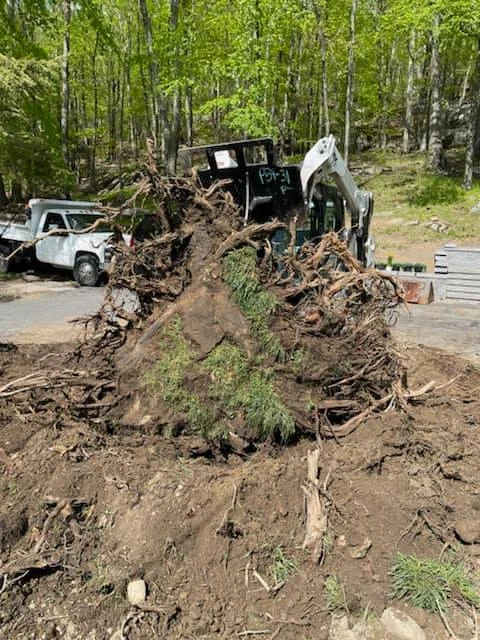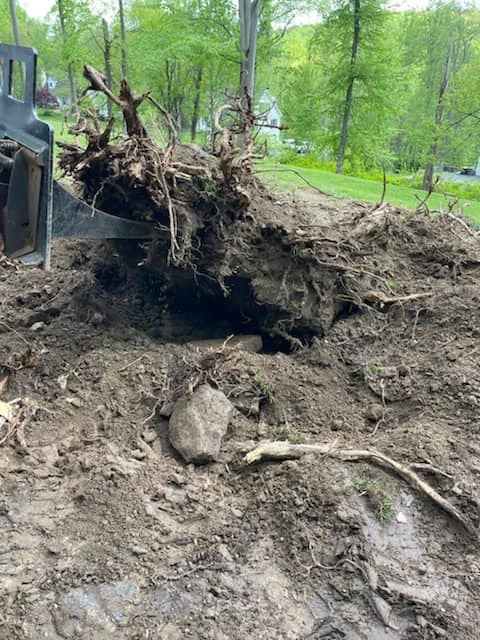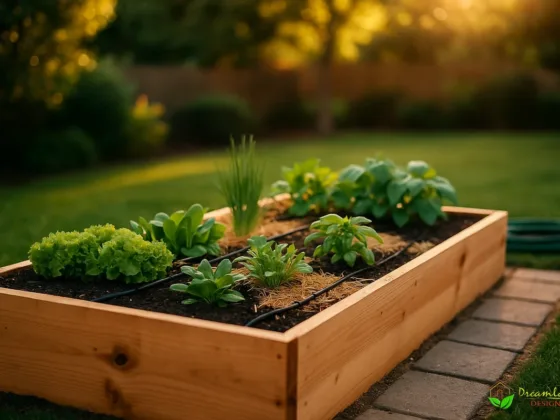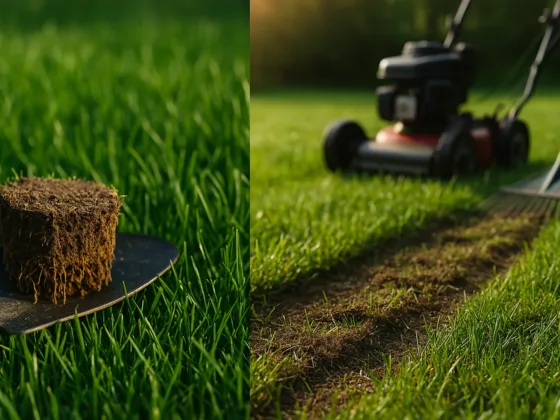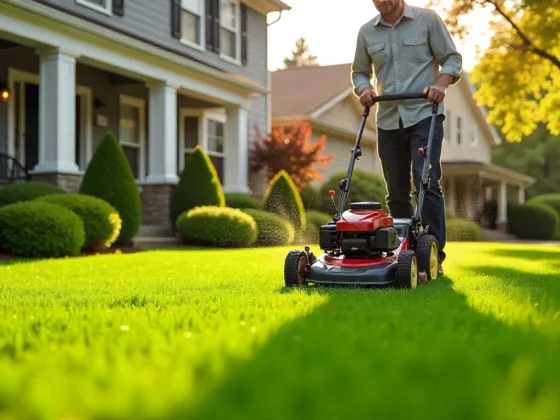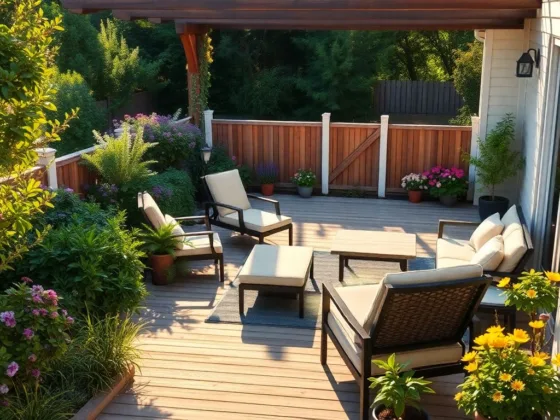Table of Contents Show
Stump removal isn’t just tidying the lawn—it’s about safety, pests, and what your mower blade will hit next weekend. If you can catch a shoe on it or feel the deck bump when you mow, the stump is already a problem. In warm months it also draws termites and carpenter ants, which don’t mind moving from dead wood to your deck posts. Below I’ll show when DIY stump removal makes sense, when a pro with a grinder is cheaper than a Saturday of digging, and how to backfill so the spot doesn’t sink by autumn.
60-second pre-check: if the stump is ≤14 in, roots are shallow, and utilities are cleared, you can usually DIY. Anything larger, buttressed, or near hardscape—bring in a grinder.
Why stumps are risky (even when they look fine)
- Trip & equipment hazards. Stumps and surface roots can cause falls and can jolt or dull mower blades. Mark the area and route foot traffic around it until removal.
- Pest pressure. Decaying wood is a buffet for termites and carpenter ants that can migrate to decks, fences, sheds, or your home—learn how to spot termite activity fast, and keep an eye on structures like deck skirting for early signs.
- Relentless regrowth. Many species (maple, willow, some oaks) resprout from stumps/roots, stealing moisture and nutrients and turning the stump into a recurring maintenance job.
- Soil settling. As buried wood decays, voids form, creating dips that collect water, kill grass, and make mowing bumpy. Removing early prevents years of minor repairs.
Stump removal options (from fastest to slowest)
1) Stump grinding (recommended)
A pro grinds the stump below grade (typically 6–12 in). It’s fast, cost-effective, and leaves the area ready for soil and seed the same day. Debris hauling is often included.
2) Full stump removal
The stump and major roots are excavated—best if you plan to replant a tree right there. Expect a larger hole to backfill and compact.
3) “Do nothing” (natural decay)
Can take 5–10 years with ongoing hazards: pests, resprouting, and soil settling. Usually a false economy.
DIY stump removal: when it’s reasonable (and when it’s not)
Safe DIY scenarios
- Small stump (≈ ≤12–14 in diameter) with shallow roots
- Clear of utilities (call your local “call before you dig” line)
- Dry, stable soil; no slope, no nearby structures or hardscape
If you’re considering a small DIY job, start with this primer on how to remove a tree stump, then choose one method below.
DIY methods (choose one)
- Manual digging + lopping: Expose root flare, cut lateral roots with loppers/recip saw, lever out stump, backfill and compact.
- Rent a small grinder: Follow manufacturer PPE and kickback warnings; grind 6–12 in below grade; rake out chips. Maintain a generous bystander keep-back zone and keep all guards in place.
- Chemical softening (Epsom salt): Drill large diameter holes, pack with salt, tarp to keep dry; weeks to months; combine with chopping. Works for small stumps only.
Never DIY these
- Burning stumps near structures/roots—fire, smoke, and code violations
- Pulling with a vehicle—snapped chains/tow straps can be deadly
- Unknown utilities—gas/electric/communications risk
- Large, buttressed stumps or tight access—hire a pro
Pro stump removal: what “good” looks like
- Pre-work utility locate and site protection (plywood over lawn)
- Grind to planned depth; chip removal or on-site reuse per your preference
- Backfill, compact, and crown the hole to offset settling
- Seed + starter fertilizer, or soil + mulch for future planting
- Advice on pest prevention and root sprout suppression
Timing by climate
- Cold climates: Early spring or late fall (softer ground, less turf stress).
- Warm climates: Avoid peak summer drought; shoulder seasons are best.
If a tree is already being removed, bundle grinding with the job to save a second mobilization—see the tree removal steps to plan the sequence.
Aftercare: restore and prevent settling
- Remove chips where you’ll plant turf; backfill with mineral soil, not pure chips. For recovery week-by-week, see seasonal lawn care tips.
- Crown 1–2 in above grade to counter future settling.
- Water lightly but regularly for 2–3 weeks; keep traffic off the area.
- If you reuse chips as mulch, keep them 3–6 in away from wood siding and door thresholds to discourage pests.
For homeowners who want to keep their outdoor spaces looking sharp year-round, resources like https://yardgoats.io/ can be a great place to pick up ideas and tips for lawn care, gardening, and landscaping projects.
Smart uses for wood chips (without creating problems)
- Pathways and garden beds (mix with soil if filling depressions)
- Compost browns; balance with greens
- Temporary mud control in side yards or work zones
For low-effort ideas that still look great, see our guide to low-maintenance landscaping and work chips into paths or mulched beds without creating future soil issues.
Quick buyer’s guide (hiring checklist)
- ISA-certified arborist or reputable stump-grinding contractor
- Written scope (depth, chip disposal, backfill/leveling)
- Proof of insurance and utility locate plan
- Photos of similar jobs; clear turnaround and cleanup standards
FAQs
6–12 inches below grade covers most grass/bed plans; deeper if installing a new tree or structure.
Grinding removes the crown, but some roots can resprout in vigorous species. Mow sprouts promptly or spot-treat per label directions to exhaust reserves.
Yes—with full stump removal or a larger excavation, fresh mineral soil, and mycorrhiza-friendly backfill. Avoid planting directly into chip-heavy spoil.
It can help small stumps soften over weeks/months; it’s not a fast or universal solution and doesn’t address major roots.
Shoulder seasons (spring/fall) reduce turf stress and make grinding easier; combine with tree removal to save costs.
Reviewed by: Allen Taylor, ISA Board Certified Master Arborist (BCMA PN-7316B); ISA Tree Risk Assessment Qualified (TRAQ); ASCA Registered Consulting Arborist (RCA #643); Tree & Plant Appraisal Qualification (TPAQ).
Independent review for safety, pest, and aftercare accuracy.
Reviewed on: October 7, 2025
Editorial note: This guide is informational and not a substitute for on-site professional assessment, especially where utilities, structures, or large stumps are involved.
Call to action
Ready to make your lawn safer and cleaner? Get two quotes for stump removal today—ask for grinding depth, cleanup, and backfill in writing. Then reclaim that space for lawn or garden.

